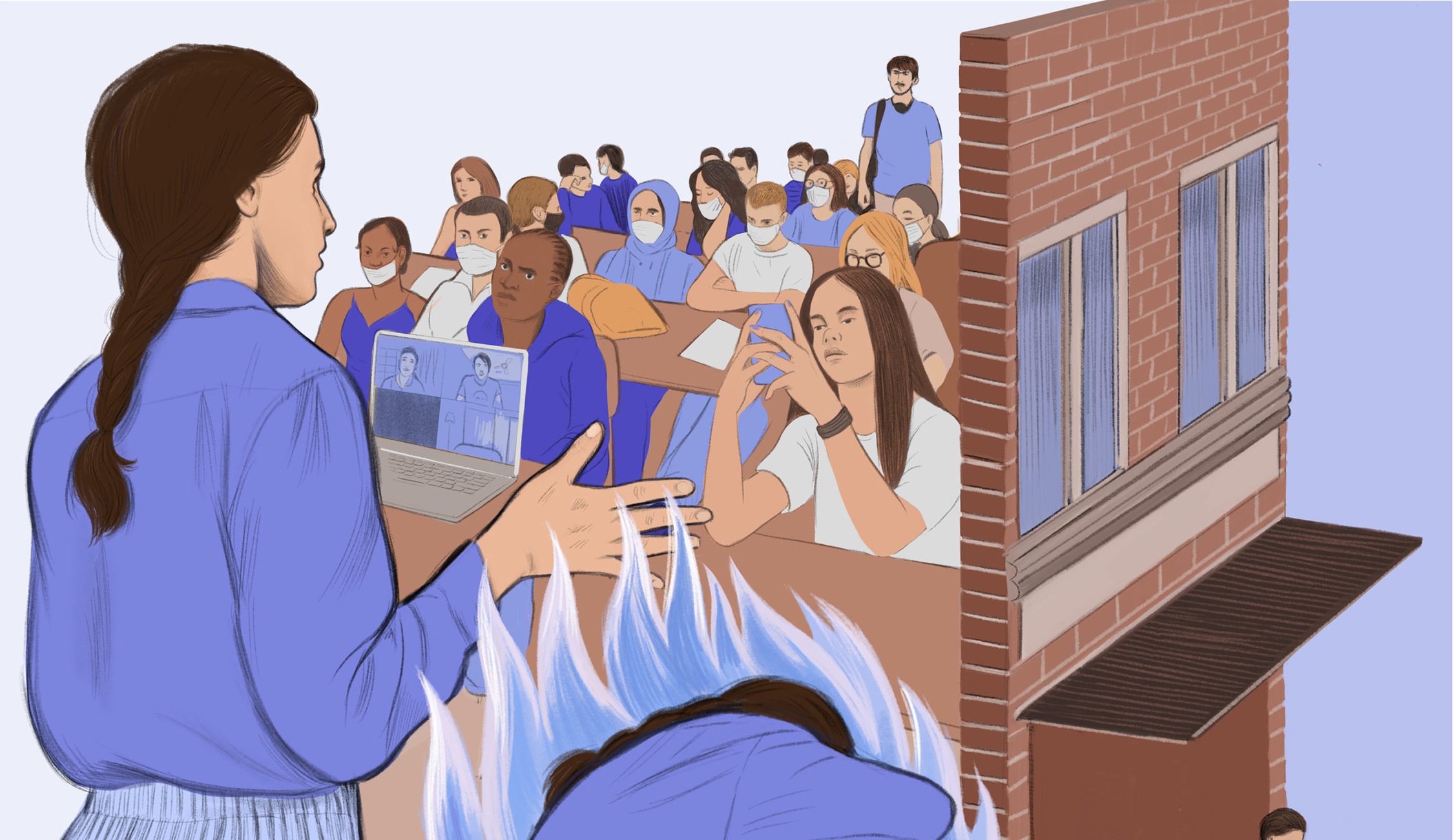
Federal Regulators Have Fast-Tracked Review of Disinfectants That Claim to Kill COVID-19
How one Texas company with no previous experience in the industry has seized a pandemic-sized opportunity.
This story was originally published by Searchlight New Mexico and is posted here as part of an ongoing collaboration with the Texas Observer.
When the college baseball season opened last February, the New Mexico Lobos were having one of their best years ever. Then COVID-19 hit. “We had a really good team and we were winning and then it just stopped—everything just turned off like it never happened,” said Ray Birmingham, the baseball coach at the University of New Mexico.
A few months later, Birmingham was in Dallas when he heard about a new business, CleanSpray Technologies, that boasted that it could disinfect an area in 90 seconds or less with a safe and environmentally sustainable liquid system. Birmingham jumped at the opportunity to install the system at UNM and get the Lobos back on the field. “I thought it was a great chance to help,” he said.
A few weeks later, in July, CleanSpray was installed in the training room of the Tow Diehm Athletic Facility. The company donated the system as a favor to Birmingham, who knows the CEO, Tony Woods, through his son. The investment would typically carry a sticker price between $10,000 and more than six figures; UNM paid only for the disinfectant liquid.
“When you stand in there, you look like you’re in a monster movie with the fog coming out of the ceiling,” said Birmingham, adding that the athletic department was pleased with the system.
But there are concerns. CleanSpray has only been in business since July, and its four founders come from backgrounds in air-conditioning, accounting, hair salons and agriculture education. Like myriad new disinfectant businesses across the country, the company saw opportunity in the pandemic—an opportunity estimated at $178.9 billion, according to the D.C.-based Household & Commercial Products Association.
“There’s not much chemistry out there that’s totally efficient at killing one type of organism, like a virus, but completely benign to a larger type of organism—i.e., humans.”
Disinfectants are regulated as pesticides by the federal government, because they are intended to kill living organisms. Now, the U.S. Environmental Protection Agency is fast-tracking the review of hundreds of products that may be effective against the coronavirus—even as many experts warn that some of these products could be dangerous to consumers and the environment, especially when overused or used incorrectly.
“There’s not much chemistry out there that’s totally efficient at killing one type of organism, like a virus, but completely benign to a larger type of organism—i.e., humans,” said Ian Cull, president of Indoor Sciences, an environmental consultancy based in Chicago.
That’s been borne out this year in New Mexico, where calls to the state Poison and Drug Information Center jumped nearly 15 percent from the same period (March through October) in 2019—just for cleaning-product misuse.
Companies nationwide are rushing to get their products on List N, the EPA’s working directory of disinfectants approved to kill the virus that causes COVID-19. In the past, the process could take anywhere from several months to two years. During the pandemic, however, a spokesperson for the EPA said it has expedited review for List N candidates. This means the time frame can be as short as one to two weeks; instead of performing its own testing, the EPA is largely relying on test data provided by the company.
Since July, the U.S. Food and Drug Administration has recommended recall of 215 hand sanitizers that use toxic chemicals, as well as sanitizers that have insufficient alcohol content. These range from ineffective to potentially lethal. Many contain methanol or 1-propanol, both of which can be toxic when absorbed through the skin, and even more so when ingested. The list of symptoms includes skin reactions, nausea, vomiting, headache, blurred vision, permanent blindness, decreased consciousness, seizures, coma, permanent damage to the nervous system and death.
The FDA is also warning consumers that some hand sanitizers are being packaged in food or drink containers like children’s food pouches, water and juice bottles, and beer cans and vodka bottles, and some contain food flavors like chocolate or raspberry.
Though the FDA is “strongly encouraging” retailers to pull these products, many remain on the shelves, leaving the responsibility to consumers to monitor their own safety.
Meanwhile, the Centers for Disease Control reported that in May and June, 15 people in New Mexico and Arizona were hospitalized with methanol poisoning from ingesting hand sanitizer. Four died, and three suffered visual impairment.
In August, the NFL’s Denver Broncos reported having players walk through a sanitizing-spray doorway much like a metal detector before entering the field to play. A Buffalo, N.Y., startup called EagleHawk has developed drones that spray disinfectant from above to sanitize large public and private venues.
Public agencies are also experimenting with a number of different methods in response to the pandemic. In southern New Mexico, for example, Ruidoso Municipal Schools is taking extravagant measures; as KRQE reported, the district has invested in six Xenex LightStrike robots that emit pulsed UV light, each with a price tag of over $100,000. Ruidoso’s superintendent declined to comment on a request from Searchlight New Mexico.
Some hospitals and hotels are using Xenex, and other UV light sanitizing technology is available for home use. Experts are divided on its efficacy. Some suggest that UV lamps, wands and boxes may be effective on small, smooth areas, but most agree they are not suitable for disinfecting large spaces. The FDA says that UV light technology has been shown to inactivate other similar viruses, but has not been proven to kill COVID-19. There is limited published data about the wavelength, dose, and duration of UVC radiation required to kill this coronavirus.
UV light only works when the surface has already been cleaned, because contaminants may protect the virus. This is also true of chemical disinfectants: “If [people] have a surface they want to disinfect they just go and spray the stuff on, and they think they’ve taken care of the problem,” said Jason Marshall of the Toxics Use Reduction Institute at the University of Massachusetts Lowell. “They’re using the chemical incorrectly—you have to clean first and then apply the disinfectant.”
While many people spray disinfectant onto surfaces and immediately wipe it away, Marshall stressed that it is critical to leave it on long enough to kill the virus—sometimes as long as ten minutes. He added that rather than spraying disinfectant indiscriminately, it is far more effective to go through your normal cleaning routine and then apply disinfectant only to high-touch areas.
“It’s a great example of how someone would think, Well it’s natural, so it must be safer for you—but that’s not always the case.”
The owners of CleanSpray built a dispersal system that uses a cost-effective disinfectant solution created by NatuReal, the Florida company that created Joy Mangano’s Miracle Clean, which is also sold under the name Bioesque.
“We wanted to make sure that the disinfectant we use is 100% botanical, all natural,” said Roger McElwrath, CleanSpray’s chief operating officer. The active ingredient is thymol—a pesticide derived from thyme—but this makes up only 0.23% of the solution by weight. The other 99.77% is inactive ingredients, many of which also have health concerns.
“It’s a great example of how someone would think, Well it’s natural, so it must be safer for you—but that’s not always the case,” said Marshall. “It may be safer than some traditional chemicals, but there are still health effects that are associated with it.” He noted that thymol may cause skin sensitization and respiratory issues.
CleanSpray’s disinfectant is probably safer than many chemicals used to combat COVID-19, including bleach.
According to the company, its dispersal system runs on an automated timer and sprays from the ceiling, grabbing COVID particles as the mist rains down. “It takes it to the surface and kills it,” said McElwrath.
There is, however, little evidence to support that claim. The American Association of Poison Control Centers warns that disinfectants for use against COVID-19 are not designed to kill viruses in the air, and excessive use increases health risks. These may include adverse effects on respiratory and reproductive systems, impairment of the central nervous system, and chronic obstructive pulmonary disease.
Despite concerns, CleanSpray has done a steady business. The company has sold and installed systems in restaurants and office buildings in the Dallas-Fort Worth area, as well as at the Good Shepherd Center, a homeless shelter in Albuquerque. The staff at Good Shepherd report that they haven’t yet had a single case of coronavirus among staff or guests. “We’re incredibly pleased with the system,” said Heather Mattax, the center’s donor assistant.
Health officials, meanwhile, warn that the coronavirus will be here indefinitely at low levels—just like the flu—and it is important to make sure that defenses against it are sustainable. Though remote spray systems like CleanSpray may reduce workers’ exposure to chemicals, they also have the potential to contribute to the kind of indiscriminate disinfectant use that could prove harmful over time.
Shortly after the system was installed at UNM, Lt. Gov. Howie Morales toured the athletic center to see if CleanSpray could be useful in opening state facilities. He said that, while the system impressed him, the state is not pursuing the option now, shifting the focus instead to masking, testing and flu shots to combat the skyrocketing positive cases that are hitting record highs.
“I think it goes back to opportunities to learn how to live with COVID-19, as we know that’s a reality,” Morales said.
Read more from the Observer:
-
After Sarah Davis’ Election Defeat, Texas Reproductive Health Advocates Worry About Losing a Powerful Republican Ally: Democrats hoped to turn the Texas House blue. Instead they flipped just one seat: the most moderate Republican and only one to support abortion rights.
-
60 Years Ago, San Antonio Teenagers Invented the Westside Sound: Also known as Chicano soul, the Westside Sound blends rock’n’roll with San Antonio roots.
-
Solar Energy is Hitting a Growth Spurt. So Is The Disinformation Around It: Anti-renewable energy campaigns are nothing new in the Lone Star State. A new wave of disinformation could spell trouble for the state’s fledgling solar industry.


